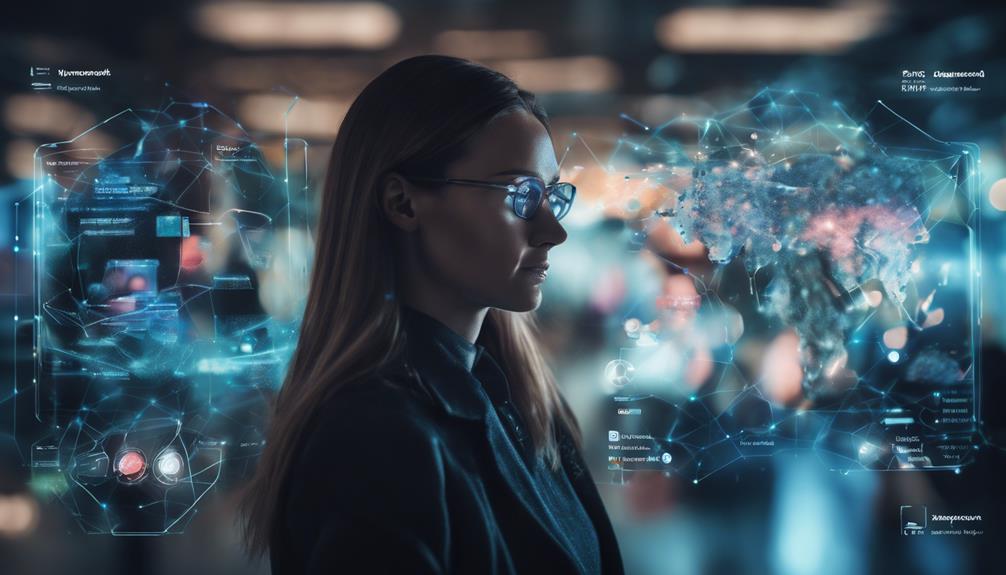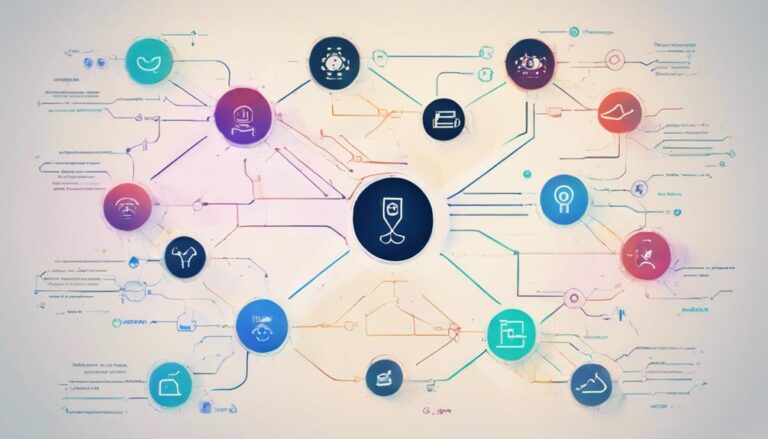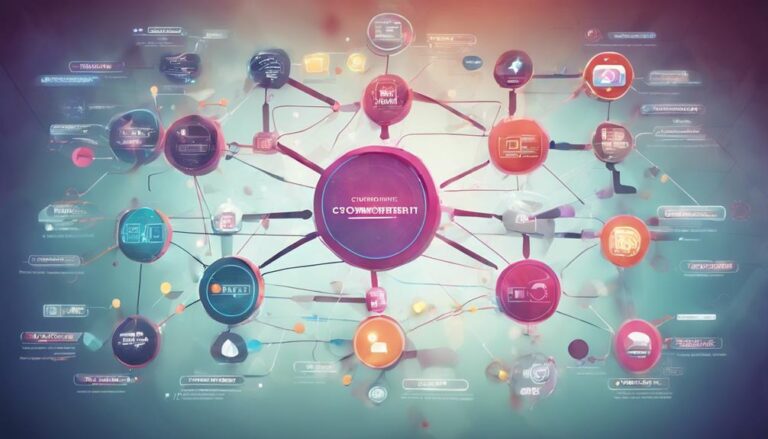When I use AI in customer journey mapping, I see incredible benefits. AI's data analysis pinpoints trends and preferences, empowering smart, data-driven decisions. Predictive analytics offer real-time, personalized insights to predict future actions. This personalization enhances our customer interactions and engagement. AI streamlines tasks and tailors experiences at scale, making every touchpoint more relevant. It identifies friction points swiftly, helping to resolve issues proactively and improve satisfaction. These advantages boost customer loyalty and optimize marketing efforts, driving efficiency and impactful strategies. There's much more to explore on how AI transforms customer journeys.
Key Takeaways
- AI enables real-time predictive analytics for personalized customer experiences.
- AI automates data analysis, enhancing decision-making efficiency and precision.
- AI identifies and resolves friction points in real-time, improving satisfaction.
- AI tailors marketing campaigns, optimizing strategies and boosting engagement.
- AI offers data-driven insights to foresee and meet customer preferences effectively.
Enhanced Data Analysis
AI's capability to analyze vast datasets with speed and precision revolutionizes how we comprehend and optimize the customer journey. By leveraging AI algorithms, I can explore data to identify trends and customer preferences, leading to data-driven decision-making.
Predictive analytics provides real-time insights, making it possible to personalize experiences and predict customer behaviors effectively. Automating data analysis with AI not only enhances efficiency but also enables more precise interactions. This level of strategic interaction means I can engage customers in ways that resonate deeply with their needs.
Utilizing AI in this manner transforms the customer journey, making it more dynamic and responsive, ultimately fostering stronger customer relationships and optimizing resource allocation for better marketing outcomes.
Predictive Customer Insights
Leveraging AI to gain predictive customer insights allows businesses to anticipate future actions and tailor personalized experiences with remarkable accuracy. By analyzing data patterns and customer behaviors, AI can forecast future purchasing decisions, enabling highly targeted marketing strategies.
Predictive customer insights help us anticipate customer needs and optimize touchpoints, resulting in enhanced engagement. AI-driven forecasting greatly improves decision-making by revealing trends in customer interactions and preferences. Through these insights, we can refine our strategies to meet customer expectations more effectively.
The ability to predict and respond to customer behaviors not only enhances satisfaction but also drives loyalty. In a competitive market, harnessing AI for predictive analytics ensures we're always a step ahead in understanding and serving our customers.
Personalized Customer Experiences

By analyzing customer data in real-time, we can craft hyper-personalized experiences that cater to individual preferences and behaviors, enhancing engagement and satisfaction.
Leveraging AI in Customer Journey mapping allows us to deliver personalized recommendations that resonate with each customer. This tailored approach not only enhances customer interactions but also greatly boosts customer engagement and loyalty.
With AI, we can optimize experiences on a large scale, ensuring every touchpoint feels unique and relevant. These hyper-personalized interactions foster stronger relationships, ultimately driving higher customer satisfaction.
As we continually refine our understanding of customer behaviors, we can keep improving our service offerings, ensuring that every interaction adds value and meets the evolving needs of our audience.
Streamlined Interactions
When we integrate AI into customer journey mapping, we streamline interactions by automating data analysis and predicting customer behaviors with remarkable accuracy. This approach transforms how we meet customer journey mapping needs and improve customer experience.
- Automated Tasks: AI handles repetitive tasks, freeing up resources and allowing for efficient resource allocation.
- Predictive Analytics: We leverage AI to analyze customer behavior and offer predictive insights, making our digital experiences more personalized.
- Real-Time Insights: AI provides real-time insights, enabling us to make data-driven decisions on the fly.
- Enhanced Personalization: By understanding individual preferences, we tailor experiences at scale, ensuring each interaction feels unique.
Identifying Friction Points

By leveraging AI, I can pinpoint friction points in real time, ensuring I address issues before they escalate.
AI's predictive capabilities allow me to foresee potential challenges and intervene proactively.
Additionally, recognizing behavioral patterns helps me understand where customers are getting frustrated, leading to targeted improvements in their journey.
Real-Time Data Analysis
Thanks to AI's capability for real-time data analysis, businesses can swiftly identify and address friction points in the customer journey, enhancing overall satisfaction. By leveraging AI algorithms, I can monitor customer interactions in real-time, allowing my business to stay agile and responsive to changing customer needs and preferences.
Here's how AI helps:
- Immediate Issue Identification: Spotting problems as they happen, enabling quick resolutions.
- Enhanced Customer Insights: Understanding customer preferences in real-time for tailored experiences.
- Proactive Engagement: Addressing potential issues before they escalate, boosting satisfaction.
- Data-Driven Decisions: Using real-time data to inform strategies, leading to higher satisfaction and loyalty.
Embracing AI for real-time data analysis guarantees we meet customer needs effectively and promptly.
Predictive Issue Detection
Utilizing AI for predictive issue detection in customer journey mapping allows us to proactively identify and resolve friction points, guaranteeing a smoother and more satisfying customer experience.
By analyzing customer interactions, AI can spot abnormal behavior like rage clicks and erratic mouse movements in real time. This predictive issue detection provides us with a micro-level view of specific causes of user struggles.
We can quickly quantify the revenue impact of these errors, which helps prioritize efforts in resolving customer abandonment issues. AI's ability to correlate data and user behavior means we can address friction points without speculation, enhancing our understanding of customer needs and improving overall satisfaction.
This innovative approach ensures we stay ahead of potential issues, driving continuous improvement.
Behavioral Pattern Recognition
By analyzing vast amounts of data, AI excels in identifying specific areas where customers encounter challenges or drop off. Through machine learning, AI can detect anomalies in customer behavior, highlighting potential areas for improvement.
Here's how it works:
- Data Analysis: AI processes large datasets to uncover hidden patterns in customer behavior.
- Anomaly Detection: Machine learning algorithms identify deviations that signal friction points.
- Predictive Insights: AI predicts customer actions, anticipating where issues may arise.
- Continuous Improvement: By pinpointing friction points, we can iteratively enhance the customer journey.
This data-driven approach ensures we address friction points effectively, enhancing overall customer satisfaction.
Optimizing Marketing Efforts
When I use AI to optimize marketing efforts, I can create personalized campaign strategies based on detailed customer data. Predictive analytics models help me understand future behaviors, making targeting and resource allocation more effective.
This leads to higher ROI and a more efficient marketing process.
Personalized Campaign Strategies
AI in customer journey mapping transforms marketing efforts by delivering personalized campaign strategies that precisely target individual preferences and behaviors. By analyzing customer behavior and preferences, AI facilitates personalized marketing that resonates deeply.
Leveraging data insights and predictive analytics, I can craft targeted campaigns that boost customer engagement and loyalty. Here's how:
- Tailored Content: AI helps in creating hyper-personalized experiences by delivering content that aligns with individual preferences.
- Efficient Strategies: It optimizes marketing efforts, ensuring resources are used effectively.
- Increased ROI: Targeted campaigns lead to higher conversion rates and better returns on investment.
- Enhanced Loyalty: Personalized interactions foster stronger customer relationships, driving long-term loyalty.
Through AI, I can design efficient strategies that maximize customer satisfaction and loyalty.
Predictive Analytics Models
By analyzing vast amounts of customer data, predictive analytics models enable us to anticipate future behaviors and preferences, ensuring our marketing efforts are both precise and impactful. AI-driven predictive analytics models allow us to create personalized marketing campaigns tailored to target audiences, enhancing customer journey mapping. This data-driven decision-making approach optimizes marketing strategies, leading to more efficient and effective customer interactions.
| Feature | Benefit | Outcome |
|---|---|---|
| Customer Data Analysis | Predict Future Behaviors | Targeted Campaigns |
| AI-Driven Insights | Personalized Marketing Campaigns | Higher Engagement |
| Data-Driven Decision-Making | Optimized Marketing Strategies | Enhanced ROI |
Frequently Asked Questions
How Is AI Used in the Customer Journey?
I use AI for data analysis and real-time insights to track customer behavior, perform sentiment analysis, and create personalization strategies. AI-driven predictive analytics, customer segmentation, journey automation, interaction optimization, and conversion forecasting enhance the entire customer journey.
What Are the Benefits of AI in Customer Support?
Using AI in customer support, I've seen chatbots' efficiency skyrocket, offering automated responses and quick query resolution. Predictive and sentiment analysis provide deep customer insights, ensuring service personalization. Virtual assistants enhance support automation and data accuracy.
What Are the Pros and Cons of AI in Customer Experience?
I've seen that AI can boost customer satisfaction by 20% with predictive analytics and sentiment analysis. However, striking a balance between automation and human touch is essential for accurate behavioral insights, data segmentation, and effective personalization strategies to prevent churn.
What Are the Advantages and Disadvantages of Customer Journey Mapping?
In my view, customer journey mapping offers rich customer insights, enabling precise persona creation and customer segmentation. It highlights pain points and optimizes touch points through journey analytics, data visualization, and feedback integration, enhancing cross-channel experience optimization.
Conclusion
To sum up, AI revolutionizes customer journey mapping by enhancing data analysis, offering predictive insights, and personalizing experiences. It streamlines interactions and identifies friction points, optimizing marketing efforts.
As the saying goes, 'Knowledge is power,' and with AI, we're empowered to understand and cater to our customers like never before. Embracing AI isn't just smart; it's essential for staying ahead in a data-driven, customer-centric world.






